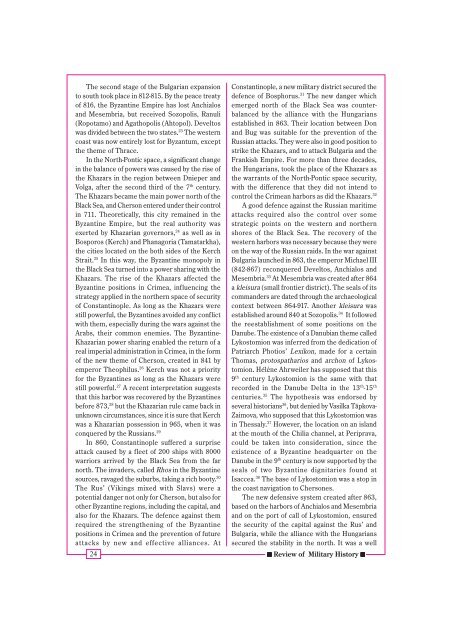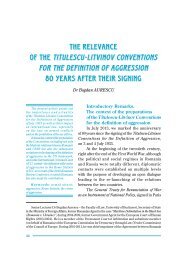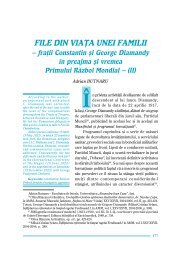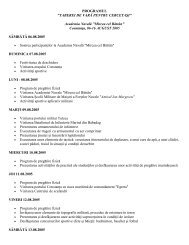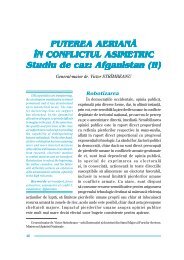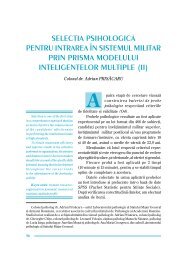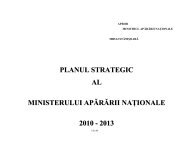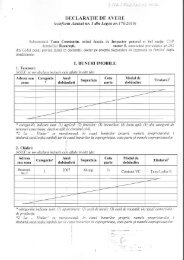You also want an ePaper? Increase the reach of your titles
YUMPU automatically turns print PDFs into web optimized ePapers that Google loves.
The second stage of the Bulgarian expansion<br />
to south took place in 812-815. By the peace treaty<br />
of 816, the Byzantine Empire has lost Anchialos<br />
and Mesembria, but received Sozopolis, Ranuli<br />
(Ropotamo) and Agathopolis (Ahtopol). Develtos<br />
was divided between the two states. 23 The western<br />
coast was now entirely lost for Byzantum, except<br />
the theme of Thrace.<br />
In the North-Pontic space, a significant change<br />
in the balance of powers was caused by the rise of<br />
the Khazars in the region between Dnieper and<br />
Volga, after the second third of the 7 th century.<br />
The Khazars became the main power north of the<br />
Black Sea, and Cherson entered under their control<br />
in 711. Theoretically, this city remained in the<br />
Byzantine Empire, but the real authority was<br />
exerted by Khazarian governors, 24 as well as in<br />
Bosporos (Kerch) and Phanagoria (Tamatarkha),<br />
the cities located on the both sides of the Kerch<br />
Strait. 25 In this way, the Byzantine monopoly in<br />
the Black Sea turned into a power sharing with the<br />
Khazars. The rise of the Khazars affected the<br />
Byzantine positions in Crimea, influencing the<br />
strategy applied in the northern space of security<br />
of Constantinople. As long as the Khazars were<br />
still powerful, the Byzantines avoided any conflict<br />
with them, especially during the wars against the<br />
Arabs, their common enemies. The Byzantine-<br />
Khazarian power sharing enabled the return of a<br />
real imperial administration in Crimea, in the form<br />
of the new theme of Cherson, created in 841 by<br />
emperor Theophilus. 26 Kerch was not a priority<br />
for the Byzantines as long as the Khazars were<br />
still powerful. 27 A recent interpretation suggests<br />
that this harbor was recovered by the Byzantines<br />
before 873, 28 but the Khazarian rule came back in<br />
unknown circumstances, since it is sure that Kerch<br />
was a Khazarian possession in 965, when it was<br />
conquered by the Russians. 29<br />
In 860, Constantinople suffered a surprise<br />
attack caused by a fleet of 200 ships with 8000<br />
warriors arrived by the Black Sea from the far<br />
north. The invaders, called Rhos in the Byzantine<br />
sources, ravaged the suburbs, taking a rich booty. 30<br />
The Rus’ (Vikings mixed with Slavs) were a<br />
potential danger not only for Cherson, but also for<br />
other Byzantine regions, including the capital, and<br />
also for the Khazars. The defence against them<br />
required the strengthening of the Byzantine<br />
positions in Crimea and the prevention of future<br />
attacks by new and effective alliances. At<br />
Constantinople, a new military district secured the<br />
defence of Bosphorus. 31 The new danger which<br />
emerged north of the Black Sea was counterbalanced<br />
by the alliance with the Hungarians<br />
established in 863. Their location between Don<br />
and Bug was suitable for the prevention of the<br />
Russian attacks. They were also in good position to<br />
strike the Khazars, and to attack Bulgaria and the<br />
Frankish Empire. For more than three decades,<br />
the Hungarians, took the place of the Khazars as<br />
the warrants of the North-Pontic space security,<br />
with the difference that they did not intend to<br />
control the Crimean harbors as did the Khazars. 32<br />
A good defence against the Russian maritime<br />
attacks required also the control over some<br />
strategic points on the western and northern<br />
shores of the Black Sea. The recovery of the<br />
western harbors was necessary because they were<br />
on the way of the Russian raids. In the war against<br />
Bulgaria launched in 863, the emperor Michael III<br />
(842-867) reconquered Develtos, Anchialos and<br />
Mesembria. 33 At Mesembria was created after 864<br />
a kleisura (small frontier district). The <strong>sea</strong>ls of its<br />
commanders are dated through the archaeological<br />
context between 864-917. Another kleisura was<br />
established around 840 at Sozopolis. 34 It followed<br />
the reestablishment of some positions on the<br />
Danube. The existence of a Danubian theme called<br />
Lykostomion was inferred from the dedication of<br />
Patriarch Photios’ Lexikon, made for a certain<br />
Thomas, protospatharios and archon of Lykostomion.<br />
Hélène Ahrweiler has supposed that this<br />
9 th century Lykostomion is the same with that<br />
recorded in the Danube Delta in the 13 th -15 th<br />
centuries. 35 The hypothesis was endorsed by<br />
several historians 36 , but denied by Vasilka Tăpkova-<br />
Zaimova, who supposed that this Lykostomion was<br />
in Thessaly. 37 However, the location on an island<br />
at the mouth of the Chilia channel, at Periprava,<br />
could be taken into consideration, since the<br />
existence of a Byzantine headquarter on the<br />
Danube in the 9 th century is now supported by the<br />
<strong>sea</strong>ls of two Byzantine dignitaries found at<br />
Isaccea. 38 The base of Lykostomion was a stop in<br />
the coast navigation to Chersones.<br />
The new defensive system created after 863,<br />
based on the harbors of Anchialos and Mesembria<br />
and on the port of call of Lykostomion, ensured<br />
the security of the capital against the Rus’ and<br />
Bulgaria, while the alliance with the Hungarians<br />
secured the stability in the north. It was a well<br />
24 ����� Review of Military History �����


